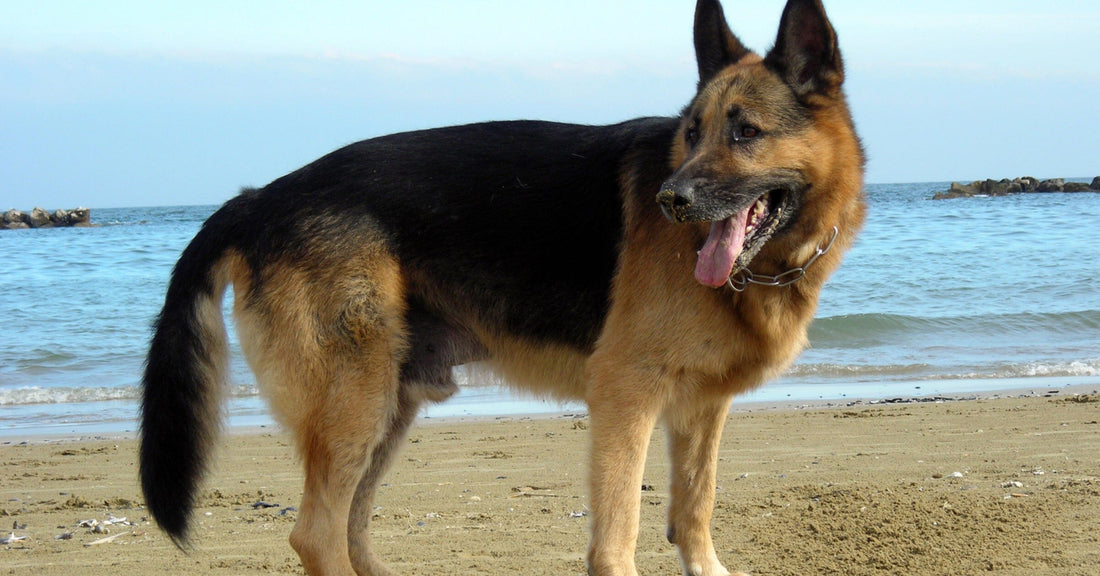The German Shepherd's Tail: Understanding Wagging, Communication, and Tail Injuries

German shepherds have a long, bushy tail that hangs down in a slight curve. It adds to their dignified appearance but also serves many purposes.
To understand the importance of the tail, it helps to understand the anatomy of the spine of the German shepherd. Their spine is made up of vertebrae divided into these five regions:
1. The neck, contains 7
2. The thoracic spine, contains 13
3. The lumbar spine, contains 7
4. The sacrum, contains 3 which are fused
5. The tail, is made up of coccygeal vertebrae similar to the tailbone in a person
Along the spine, the vertebrae are stacked one behind the other, like people. There are discs between the vertebrae that cushion the bones. In between each vertebra, there are facet joints held together by ligaments and surrounded by muscles, which allow movement.

There is a bony tube on the top of each vertebra that forms the spinal canal, which the spinal cord passes through. The spinal canal is very protected. It’s surrounded by the delicate nerve tissue that transmits messages between the brain and other parts of the body.
So, your dog’s tail is an extension of its spine. The tail muscles and nerves enable your dog to move its tail at will due to a complex system of bone, muscles, nerves, and blood vessels, which allow impulses to reach the brain.
Your dog’s tail serves many important functions. It allows your dog to signal emotions to communicate with you and other dogs and, in smaller part, helps with balance and stability.
Since dogs communicate with people and other dogs in large part through their tails, it’s important to consider all of their body language, including their posture, eyes, ears, mouth, and fur along with determining what their tail movement means.

Some of the ways your dog communicates with its tail include:
• Wide tail wagging
Tail wide and loose wagging tail is the most recognizable greeting given by dogs. It usually signals happiness, and excitement, in anticipation of something, and communicates they’re friendly.
• Stiff tail wagging
A stiff, rigid, rapid wag along with a ridged posture may indicate less than friendly intentions. A dog stiffly wagging its tail may be letting you know they are agitated or aggressive and will defend itself or its property.
• Curled up tail
German shepherd’s tail normally is down so but when it's curled up toward or over its back, it can also be a signal that they feel threatened and give a back-off message.

• Horizontal tail
When a dog holds their tail out straight, they are usually feeling confident or good about themselves.
• Low, slow-wagging tail
A low, slow wag may signal that the dog is scoping out a situation. They may be undecided, uncertain, or even a little nervous.
• Tucked tail
A tail tucked between the legs usually signals fear, submission, or anxiety.
• Neutral tail
A calm, comfortable dog will usually hold their tail in a neutral position, hanging down comfortably. The tail is neither stiff, tucked, nor upright and their body language is relaxed.

• Low, hanging down tail
When dogs are sick or in pain, they’ll often hold their tail low and close to the body. They may not wag their tail at all.
By spending some time watching your dog’s tail movements in different situations, you’ll gain a lot of insight into their mood. Soon, you’ll be able to read their body language with a simple glance at their tail.
Tail Injuries
The tail can also be injured and if that happens, it can be a very painful problem for your dog. Tail injuries can at times be hard to heal, which only adds to the problem and occasionally ends in amputation.

Some common tail injuries include:
• Cuts and abrasions
Sometimes dogs will superficially cut or scrape their tail when they’re playing or wagging. Usually, these injuries are minor and can be cleaned with soap and water. If the dog won’t leave their tail alone, they may need to wear an e-collar to give it a chance to heal.
• Lacerations
Lacerations can happen for many reasons and are more serious than abrasions. Lacerations may expose the muscles or bone and may require sutures. If your dog has a laceration, wrap the tail with a towel to control the bleeding and go to the vet.
• Tail biting
Tail biting can be caused by many reasons, and you’ll need to get to the root of the problem to solve it. Anxieties, boredom, full or impacted anal glands, fleas or other pests, and more can all lead to the problem.

• Happy tail
Fortunately, German shepherds don’t have this problem as much as some other breeds. Happy tail happens when a dog constantly wags its tail and hits it repeatedly on things that cause cuts and ulcerations. Happy tail can be serious since it’s almost impossible to control tail wagging and usually ends in requiring medical intervention.
• Limber tail
Working dogs can be prone to overexertion, which results in pain at the base of their tail. The symptoms are similar to a limp tail or a fractured tail, so it is best to take your dog to the vet for an evaluation.
• Limp tail
A tail that suddenly goes limp can be a signal of a spine problem or an avulsion injury. An avulsion injury happens when the tail is pulled and stretched enough to tear nerves and can result in nerve damage higher up the spinal cord and result in incontinence and other serious problems.

• Fractured tail
A fractured tail can happen for many reasons, such as a fall or traumatic injury. The severity of the fracture is determined by where it is located. The closer to the base of the tail, the more serious and can result in nerve damage. A dog with a tail fracture should always see a vet.
*If your dog’s tail is very painful, or broken, the tissue color has changed, is severely bleeding, or you can see deep tissue, bone, or nerves, you should always go to the veterinarian. Changes in the tail can also signal neurological problems with the spine.
The tail can tell us a lot about our dogs. It’s an important communication device and is also an important indicator of their health and well-being. Any tail problems or injuries should be taken seriously.

We hope you enjoyed learning more about your dog’s tail. As always, please feel free to share with your friends.
You might also like: German Shepherd Health Check: Monthly Wellness Routine For A Happy and Healthy Dog
























